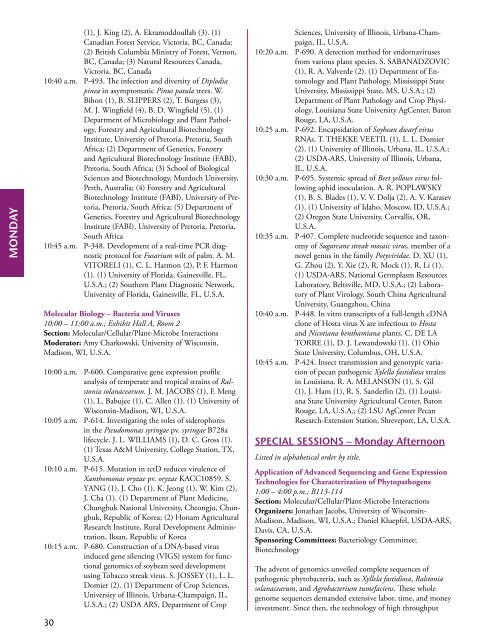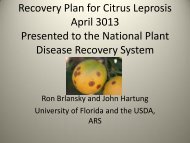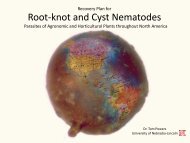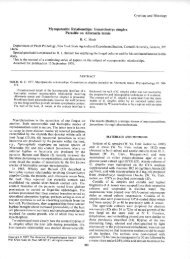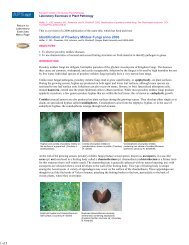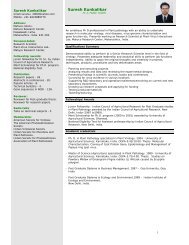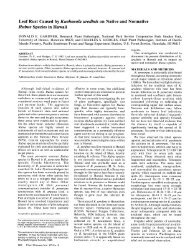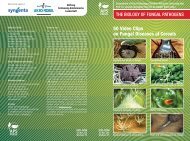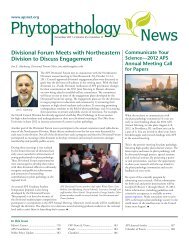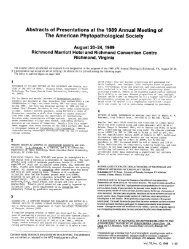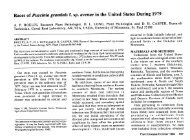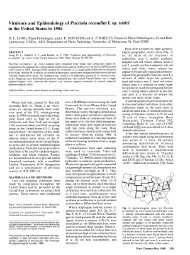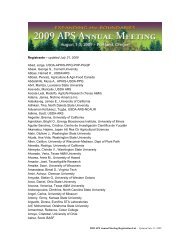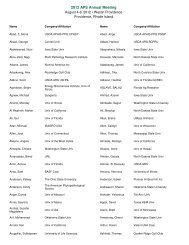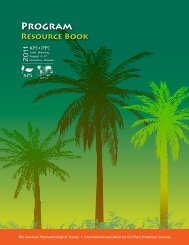Annual Meeting Program Book - American Phytopathological Society
Annual Meeting Program Book - American Phytopathological Society
Annual Meeting Program Book - American Phytopathological Society
Create successful ePaper yourself
Turn your PDF publications into a flip-book with our unique Google optimized e-Paper software.
MondaY<br />
(1), J. King (2), A. Ekramoddoullah (3). (1)<br />
Canadian Forest Service, Victoria, BC, Canada;<br />
(2) British Columbia Ministry of Forest, Vernon,<br />
BC, Canada; (3) Natural Resources Canada,<br />
Victoria, BC, Canada<br />
10:40 a.m. P-493. The infection and diversity of Diplodia<br />
pinea in asymptomatic Pinus patula trees. W.<br />
Bihon (1), B. SLIPPERS (2), T. Burgess (3),<br />
M. J. Wingfield (4), B. D. Wingfield (5). (1)<br />
Department of Microbiology and Plant Pathology,<br />
Forestry and Agricultural Biotechnology<br />
Institute, University of Pretoria, Pretoria, South<br />
Africa; (2) Department of Genetics, Forestry<br />
and Agricultural Biotechnology Institute (FABI),<br />
Pretoria, South Africa; (3) School of Biological<br />
Sciences and Biotechnology, Murdoch University,<br />
Perth, Australia; (4) Forestry and Agricultural<br />
Biotechnology Institute (FABI), University of Pretoria,<br />
Pretoria, South Africa; (5) Department of<br />
Genetics, Forestry and Agricultural Biotechnology<br />
Institute (FABI), University of Pretoria, Pretoria,<br />
South Africa<br />
10:45 a.m. P-348. Development of a real-time PCR diagnostic<br />
protocol for Fusarium wilt of palm. A. M.<br />
VITORELI (1), C. L. Harmon (2), P. F. Harmon<br />
(1). (1) University of Florida, Gainesville, FL,<br />
U.S.A.; (2) Southern Plant Diagnostic Network,<br />
University of Florida, Gainesville, FL, U.S.A.<br />
Molecular Biology – Bacteria and Viruses<br />
10:00 – 11:00 a.m.; Exhibit Hall A, Room 2<br />
Section: Molecular/Cellular/Plant-Microbe Interactions<br />
Moderator: Amy Charkowski, University of Wisconsin,<br />
Madison, WI, U.S.A.<br />
10:00 a.m. P-600. Comparative gene expression profile<br />
analysis of temperate and tropical strains of Ralstonia<br />
solanacearum. J. M. JACOBS (1), F. Meng<br />
(1), L. Babujee (1), C. Allen (1). (1) University of<br />
Wisconsin-Madison, WI, U.S.A.<br />
10:05 a.m. P-614. Investigating the roles of siderophores<br />
in the Pseudomonas syringae pv. syringae B728a<br />
lifecycle. J. L. WILLIAMS (1), D. C. Gross (1).<br />
(1) Texas A&M University, College Station, TX,<br />
U.S.A.<br />
10:10 a.m. P-615. Mutation in tctD reduces virulence of<br />
Xanthomonas oryzae pv. oryzae KACC10859. S.<br />
YANG (1), J. Cho (1), K. Jeong (1), W. Kim (2),<br />
J. Cha (1). (1) Department of Plant Medicine,<br />
Chungbuk National University, Cheongju, Chungbuk,<br />
Republic of Korea; (2) Honam Agricultural<br />
Research Institute, Rural Development Administration,<br />
Iksan, Republic of Korea<br />
10:15 a.m. P-680. Construction of a DNA-based virus<br />
induced gene silencing (VIGS) system for functional<br />
genomics of soybean seed development<br />
using Tobacco streak virus. S. JOSSEY (1), L. L.<br />
Domier (2). (1) Department of Crop Sciences,<br />
University of Illinois, Urbana-Champaign, IL,<br />
U.S.A.; (2) USDA ARS, Department of Crop<br />
30<br />
Sciences, University of Illinois, Urbana-Champaign,<br />
IL, U.S.A.<br />
10:20 a.m. P-690. A detection method for endornaviruses<br />
from various plant species. S. SABANADZOVIC<br />
(1), R. A. Valverde (2). (1) Department of Entomology<br />
and Plant Pathology, Mississippi State<br />
University, Mississippi State, MS, U.S.A.; (2)<br />
Department of Plant Pathology and Crop Physiology,<br />
Louisiana State University AgCenter, Baton<br />
Rouge, LA, U.S.A.<br />
10:25 a.m. P-692. Encapsidation of Soybean dwarf virus<br />
RNAs. T. THEKKE VEETIL (1), L. L. Domier<br />
(2). (1) University of Illinois, Urbana, IL, U.S.A.;<br />
(2) USDA-ARS, University of Illinois, Urbana,<br />
IL, U.S.A.<br />
10:30 a.m. P-695. Systemic spread of Beet yellows virus following<br />
aphid inoculation. A. R. POPLAWSKY<br />
(1), B. S. Blades (1), V. V. Dolja (2), A. V. Karasev<br />
(1). (1) University of Idaho, Moscow, ID, U.S.A.;<br />
(2) Oregon State University, Corvallis, OR,<br />
U.S.A.<br />
10:35 a.m. P-407. Complete nucleotide sequence and taxonomy<br />
of Sugarcane streak mosaic virus, member of a<br />
novel genus in the family Potyviridae. D. XU (1),<br />
G. Zhou (2), Y. Xie (2), R. Mock (1), R. Li (1).<br />
(1) USDA-ARS, National Germplasm Resources<br />
Laboratory, Beltsville, MD, U.S.A.; (2) Laboratory<br />
of Plant Virology, South China Agricultural<br />
University, Guangzhou, China<br />
10:40 a.m. P-448. In vitro transcripts of a full-length cDNA<br />
clone of Hosta virus X are infectious to Hosta<br />
and Nicotiana benthamiana plants. C. DE LA<br />
TORRE (1), D. J. Lewandowski (1). (1) Ohio<br />
State University, Columbus, OH, U.S.A.<br />
10:45 a.m. P-424. Insect transmission and genotypic variation<br />
of pecan pathogenic Xylella fastidiosa strains<br />
in Louisiana. R. A. MELANSON (1), S. Gil<br />
(1), J. Ham (1), R. S. Sanderlin (2). (1) Louisiana<br />
State University Agricultural Center, Baton<br />
Rouge, LA, U.S.A.; (2) LSU AgCenter Pecan<br />
Research-Extension Station, Shreveport, LA, U.S.A.<br />
sPeCIal sessIons – Monday afternoon<br />
Listed in alphabetical order by title.<br />
Application of Advanced Sequencing and Gene Expression<br />
Technologies for Characterization of Phytopathogens<br />
1:00 – 4:00 p.m.; B113-114<br />
Section: Molecular/Cellular/Plant-Microbe Interactions<br />
Organizers: Jonathan Jacobs, University of Wisconsin-<br />
Madison, Madison, WI, U.S.A.; Daniel Kluepfel, USDA-ARS,<br />
Davis, CA, U.S.A.<br />
Sponsoring Committees: Bacteriology Committee;<br />
Biotechnology<br />
The advent of genomics unveiled complete sequences of<br />
pathogenic phytobacteria, such as Xyllela fastidiosa, Ralstonia<br />
solanacearum, and Agrobacterium tumefaciens. These whole<br />
genome sequences demanded extensive labor, time, and money<br />
investment. Since then, the technology of high throughput


